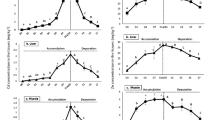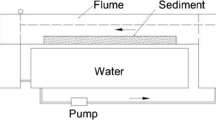Abstract
A study was made of the dynamics of non-dietary cadmium in fish exposed to different concentrations of cadmium and zinc in water. Zebrafish,Brachydanio rerio, were exposed to Cd and Zn for various periods. The fate of a short “pulse” of the radioactive tracer109Cd (3 or 9 days) was studied during a post-pulse period of 53 or 83 days. The tracer elimination and accumulation were described by exponential equations. The constants obtained from regression analysis of the results were used as a tool for evaluation of the findings.
The majority of the109Cd taken up in the gills during the pulse period was retained in the gill tissue and slowly transferred to the internal organs or lost to the water during the post-pulse period. The retention of tracer in the gills after a 3-day109Cd pulse was increased by Zn but not influenced by Cd. Continuous exposure to stable Cd increased the rate of turnover of the retained109Cd. Both Cd and Zn increased the tracer accumulation in the liver and kidney. The results also indicated that the effect of Zn on the Cd turnover might be lost if the environmental Zn is withdrawn before the start of the109Cd pulse.
A tendency of increased mortality of the fish exposed to 1 μg Cd/L for 2–3 months suggested that low concentrations of Cd is toxic to the fish during chronic exposure. The increased Cd uptake and transfer in the gills, caused by Zn, could have deleterious effects on the fish. It might also reflect a change in the form of transport and in the intracellular handling of the metal, which protects the fish from Cd toxicity. However, a Zn pre-exposure did not decrease the mortality, which suggests that Zn did not protect the fish from Cd toxicity.
Similar content being viewed by others
References
Bradley RW, DuQuesnae C, Sprague JB (1985) Acclimation of rainbow trout,Salmo gairdneri, Richardson, to zinc: Kinetics and mechanism of enhanced toleration induction. J Fish Biol 27:367–379
Duncan DA, Klaverkamp JF (1983) Tolerance and resistance to cadmium in white suckers,Catostomus commersoni, previously exposed to cadmium, mercury, zinc, or selenium. Can J Fish Aquat Sci 40:128–138
Engström B, Nordberg GF (1979) Factors influencing absorption and retention of oral109Cd in mice: Age, pretreatment and subsequent treatment with nonradioactive cadmium. Acta pharmacol et toxicol 45:315–324
Foulkes EC, McMullen DM (1986) Endogenous metallothionein as determinant of intestinal cadmium absorption: a reevaluation. Toxicology 38:285–291
Hamilton SJ, Mehrle PM (1986) Metallothionein in fish: Review of its importance in assessing stress from metal contaminants. Trans Amer Fish Soc 115:596–609
Hatakeyama S, Yasuno M (1982) Accumulation and effects of cadmium on guppy,Poecilia reticulata, fed cadmium-dosed Cladocera,Monia macropoda. Bull Environ Contam Toxicol 29:159–166
Karlsson-Norrgren L, Runn P (1985) Cadmium dynamics in fish: Pulse studies with109Cd in female zebrafish,Brachydanio rerio. J Fish Biol 27:571–581
Kito H, Ose Y, Sato T (1986) Cadmium-binding protein (metallothionein) in carp. Environ Health Perspect 66:117–124
Klaverkamp JF, Duncan DA (1987) Acclimation to cadmium toxicity by white suckers: Cadmium binding capacity and metal distribution in gill and liver cytosol. Environ Toxicol Chem 6:275–289
Klaverkamp JF, Macdonald WA, Duncan DA, Wagemann R (1984) Metallothionein and acclimation to heavy metals in fish: A review. In: Cairns VW, Hodson PV, Nriagu JO (eds) Contaminant effects on fisheries. Wiley, New York, pp 99–313
Kumada H, Kimura S, Yokote M (1980) Accumulation and biological effects of cadmium in rainbow trout. Bull Freshwater Fish Res Lab 46:97–103
Pärt P (1983) Cadmium uptake in perfused rainbow trout gills. Mechanisms and effects of water quality. Acta Universitalis Upsaliensis, Dissertation from the Faculty of Science 707, ISBN 91-554-1474-5
Verbost PM, Flik G, RAC Lock, Wendelaar Bonga SE (1987) Cadmium inhibition of Ca2+-uptake in rainbow trout gills. Amer J Physiol 253:R216-R221
Wicklund A, Runn P, Norrgren L (1988) Cadmium and zinc interactions in fish: Effects of zinc on the uptake, organ distribution, and elimination of109Cd in the zebrafish,Brachydanio rerio. Arch Environ Contam Toxicol 17:345–354
Williams DR, Giesy JP Jr (1978) Relative importance of food and water sources to cadmium uptake byGambusia affinis, Poeciliidae. Environ Res 16:326–332
Wynne JD (1982) Learning statistics. Macmillan, New York
Author information
Authors and Affiliations
Rights and permissions
About this article
Cite this article
Wicklund, A., Norrgren, L. & Runn, P. The influence of cadmium and zinc on cadmium turnover in the zebrafish,Brachydanio rerio . Arch. Environ. Contam. Toxicol. 19, 348–353 (1990). https://doi.org/10.1007/BF01054977
Received:
Revised:
Issue Date:
DOI: https://doi.org/10.1007/BF01054977




